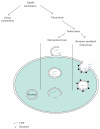Mechanisms of cellular uptake of cell-penetrating peptides
- PMID: 21687343
- PMCID: PMC3103903
- DOI: 10.1155/2011/414729
Mechanisms of cellular uptake of cell-penetrating peptides
Abstract
Recently, much attention has been given to the problem of drug delivery through the cell-membrane in order to treat and manage several diseases. The discovery of cell penetrating peptides (CPPs) represents a major breakthrough for the transport of large-cargo molecules that may be useful in clinical applications. CPPs are rich in basic amino acids such as arginine and lysine and are able to translocate over membranes and gain access to the cell interior. They can deliver large-cargo molecules, such as oligonucleotides, into cells. Endocytosis and direct penetration have been suggested as the two major uptake mechanisms, a subject still under debate. Unresolved questions include the detailed molecular uptake mechanism(s), reasons for cell toxicity, and the delivery efficiency of CPPs for different cargoes. Here, we give a review focused on uptake mechanisms used by CPPs for membrane translocation and certain experimental factors that affect the mechanism(s).
Figures
References
-
- Järver P, Langel Ü. Cell-penetrating peptides—a brief introduction. Biochimica et Biophysica Acta. 2006;1758(3):260–263. - PubMed
-
- El-Andaloussi S, Holm T, Langel Ü. Cell-penetrating peptides: mechanisms and applications. Current Pharmaceutical Design. 2005;11(28):3597–3611. - PubMed
-
- Green M, Loewenstein PM. Autonomous functional domains of chemically synthesized human immunodeficiency virus tat trans-activator protein. Cell. 1988;55(6):1179–1188. - PubMed
-
- Vivès E, Brodin P, Lebleu B. A truncated HIV-1 Tat protein basic domain rapidly translocates through the plasma membrane and accumulates in the cell nucleus. Journal of Biological Chemistry. 1997;272(25):16010–16017. - PubMed
LinkOut - more resources
Full Text Sources
Other Literature Sources


